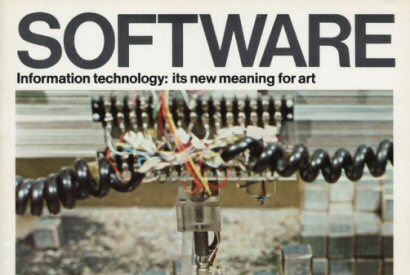Sylvie Lacerte
9 Evenings and Experiments in Art and Technology
I shall refer here to Edward Shanken's lecture at Siggraph 2001, “Art in the Information Age: Technology and Conceptual Art,” (1) where he compared conceptual art with technological art, in reference to Jack Burnham’s theory of software, from his eponymous exhibition Software – Information Technology: its new meaning for art, held at the Jewish Museum in New York in 1970. Shanken writes that in the exhibition catalogue, Burnham “conceived of software as parallel to the aesthetic principles, concepts, or programs that underlie the formal embodiment of the actual art objects, which in turn parallel to hardware. (2)
Conceptual artists such as Vito Acconci, John Baldessari, Robert Barry, Hans Haacke, Douglas Huebler, Joseph Kosuth, Les Levine and Lawrence Weiner, to name a few, were part of Burnham's show. I therefore decided to pursue the exercise by taking the dialectical trope of conceptual art and technological art a few steps further by mere extrapolation of the mind, inspired as I was by Lucy R. Lippard's influential Six years: The dematerialization of the art object from 1966 to 1972, (3) only to realise that conceptual art and technological art were not as far apart from each other as we have been led to believe.
To illustrate this hypothesis, I devised the following dialectical chart:
Conceptual art vs. Technological Art
Software (Burnham) vs. Hardware (Burnham)
Dematerialization vs. Materialization / too much apparatus
Benjamin's prevailing aura vs. Reification of the art object
Idea of the artwork vs. Art object fetishism
Language/sign (Semiotics) vs. Object/body language - emotions
Cerebral experience vs. Sensuous experience
Communication (Lippard) vs. Community (Lippard)
Distribution (Lippard) vs. Accessibility (Lippard)
In the chart, I try to characterize what distinguishes one art movement from the other, bearing in mind the opposing views that defined each camp at the time. I should add that the camps were mostly conceptualized by art critics and theoreticians and not by the artists themselves. And although it might seem like a heresy to assign Benjamin's aura to an art current that put forth the dematerialization of the art object, while Benjamin’s aura focused on the art work as an object, it is my presumption that many artists of the period, including conceptual artists, still wished to have people feel the aura surrounding their work of art, whether dematerialized or not.
Lucy R. Lippard states:
“Communication (but not community) and distribution (but not accessibility) were inherent in Conceptual art. Although the forms pointed toward democratic outreach, the content did not. (...) Contact with a broader audience was vague and undeveloped.” (4)
It is known that conceptual art was about ideas, concept, process and content and that technological art was considered to be more results and object oriented. This comparison was bound to generate a hierarchy between the two genres. However, many of the 9 Evenings performances were also about ideas, concept, process and content as well as experience and interaction. And paradoxically, if we refer to the dialectical chart and Lippard's hypothesis, Klüver was not much of a communications man, nor was he interested in accessibility. He still thought in terms of the Kantian paradigm in so far as art should be self-explanatory. And, while a broad audience saw and experienced 9 Evenings, accessibility was seemingly never attained. As a result, the critics became irate and eventually lost total interest in the phenomenon. Later art historians never really made an effort to relate EAT's chronicles, contrary to the case with conceptual art, whose history and astonishing sales have been amply documented.
Per Biorn, one of the 9 Evenings engineers who later collaborated with many artists, (5) disagreed with Klüver's philosophy. He said:
“I was disappointed when Klüver said: “We will present it, but we will explain nothing.” (...) If we had explained a few things, the critics might not have been as ferocious. (...) We want the public to see it, but we don't give them enough tools to appreciate the technology with the art. (...) Information should be available to people who want it.” (6)
Moreover, not only did the public need help, but so did the engineers, as most knew nothing about modern or contemporary art. Consequently, there were many moments when it was very difficult for the engineers to comprehend what the artists wanted to achieve in their performances.
In answer to the question, “What do you think Billy Klüver is trying to do?” posed by Harriet De Long as part of the preparation of a book on 9 Evenings, Pontus Hulten responded:
“He's not trying it, he's doing it. Few people understand it. He's trying to break down borders. I don't know how aware of it he is, but he mainly is doing something social. That's very unpopular in this country. Billy gets industry interested, or aware, in the fact that the artist is really an existing person, not just a monkey who appears in magazines. (...) What makes it hard to understand Billy, is that he speaks two languages, and he sometimes speaks both of them at the same time.” (7)
Lippard adds: “There was a decidedly puritanical cast to much conceptual art, as well as a fascination with pseudo-scientific data and neo-philosophical gobbledygook.” (8) This puritanical reluctance to communicate, mediate or reveal what was shown to the public was apparently common to the heritage of all our protagonists, whether they were admittedly working with technology (Klüver) or not (conceptual artists). (9) Of course, this only complicates the explanation of the apparent paradox between the two genres. Conceptual art, as Lippard stated, was puritanical, catering to few art cognoscenti, while on the other hand, the art put forth in 9 Evenings was more theatrical, very physical, and catering (theoretically) to larger numbers of people. In view of this, we may now start to understand a few of the motives that may have prompted art critics to overlook EAT's activities and the impetus this organization generated towards a new collaborative and interdisciplinary mode of working for the creation of art works - technological, conceptual or other – to date.
Sylvie Lacerte © 2005 FDL
(1) Edward A. Shanken, “Art in the Information Age: Technology and Conceptual Art,” Siggraph 2001 Explore Interaction and Digital Images (New York: ACM Siggraph, 2001) pp. 8-15.
(2) Idem.
(3) Lucy R. Lippard, Six Years: The Dematerialization of the Art Object from 1966 to 1972..., (Berkeley/London, Los Angeles: University of California Press, 1997 (1973)).
(4) Lippard, Idem, p. xvi.
(5) Yvonne Rainer, Carolee Schneemann, etc.
(6) Interview with Per Biorn, produced by the Daniel Langlois foundation for Art, Science and Technology; interviewers : Vincent Bonin, Éric Legendre, Julie Martin (4 videocassettes (3 hr., 45 min.) : master, col., sound, Mini-DV, Shot the 25 of August, 2004) Interview made the 25 of August, 2004 in Berkeley Heights (N.J. USA) Interview also recorded on audiotape (3 Minidiscs). The Daniel Langlois Foundation for Art, Science, and Technology, 9 Evenings: Theatre and Engineering fonds. 9 EVE 00032223.
(7) 9 Evenings : Theatre and Engineering (manuscript) / Harriet DeLong, Experiments in Art and Technology.-1966-1967 (1972-1973). Box 1. Experiments in Art and Technology. Records, 1966-1993, Research Library, The Getty Research Institute, Los Angeles, California (940003).
(8) Lippard, Op. Cit., p. xvi.
(9) This too is gobbledygook, as it's been shown above that some conceptual artists have also made ample use of technology's tools and devices in the realization of their installations.



